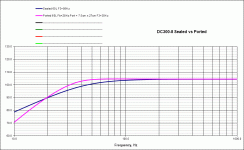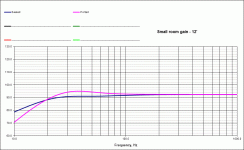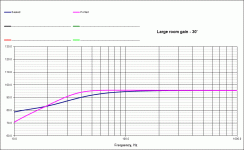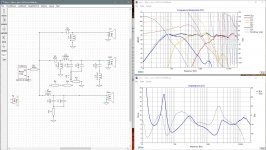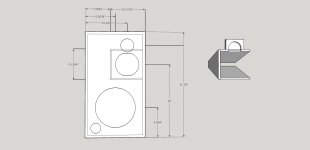Should have no problems at all; it is after all rated at 89dB.
Ignore the porting for the Tarkus as you are using a different woofer.
I still think that woofer suits sealed better in that size box, but fully stuffed with fibreglass.
Running the amp into a load in the middle of its range is excellent.
One thing I would do is offset the midrange and tweeter to one side of the box and mirror image the boxes, it does make a difference and try and get the mid and tweeter as close together as you can
Ignore the porting for the Tarkus as you are using a different woofer.
I still think that woofer suits sealed better in that size box, but fully stuffed with fibreglass.
Running the amp into a load in the middle of its range is excellent.
One thing I would do is offset the midrange and tweeter to one side of the box and mirror image the boxes, it does make a difference and try and get the mid and tweeter as close together as you can
Moondog is absolutely right, in which looking at the data for the woofer and the music you listen to, sealed would be the way to go. AND, it'll be easier on your end to assemble, as with a port there are many other things you have to worry about. Just to name a few, port noise, box tuning frequency, xmax limitations, etc. I did some super quick calculations, not sure how accurate they are, but if you're running sealed in that size enclosure, then you should be able to get it down to anywhere from high 30's to mid 40's. Now are you planning on using DSP?
If front porting much different than rear porting? The Tarkus ports are longer than my cabinets are deep,
In the case of a 3-way, the only problem with a rear firing port would be if the speaker is right up against the back wall. Not a problem here.
Also, you can bend ports when they are too long for the depth of the cabinet. Standard plumbing pipe with a 45 or 90 degree elbow work fine.
Attached is the DC300-8 sealed vs ported in 60L. Here's a drawback to the Tarkus mid - it needs a fairly large box, 13L internal in the original design which leaves less room for the woofer volume. Other mid choices could work in 4-6L which will give a lower F3 for the woofer with 10 extra liters.
Again I think Rich's suggestion is best - go ported and stuff it if you think that sounds better. And I think room gain in a large room will match better with the ported version since it will start lower in frequency than where the sealed version starts to roll-off up around 100Hz.
Attachments
The Peerless midwoofer does not need more than 3L when crossed that high.
I have heard single box Tarkii with 200in3 mid compartments.
Excellent.
Those boxes are almost identical to my old Criterions-same weird tweeter layout too.
I have heard single box Tarkii with 200in3 mid compartments.
Excellent.
Those boxes are almost identical to my old Criterions-same weird tweeter layout too.
Going that small for that driver makes me uncomfortable. I would still suggest more than that for stuffing and room to breath. I just did a sim with 10L for the mid and 60L ported for the woofer and without baffle step loss so sensitivity stays up at 90dB at 1m. Both the tweeter and the mid make it up to the required SPL levels and both without a single resistor for attenuation. In the case of the tweeter, that's not a problem but in the case of the mid, it required a few more not inexpensive parts to tame the mid's resonance peak. Previously the L-pad shunt resistor was performing a double duty of overall attenuation and attenuating the resonance but the L-pad had to be pulled to get the necessary SPL's.
I still need to look at it at about 3dB of baffle step loss to see if that will work too but I don't see that it shouldn't. I also looked at the SB 13PFC-4 but nope, not enough SPL to work in this situation.
I still need to look at it at about 3dB of baffle step loss to see if that will work too but I don't see that it shouldn't. I also looked at the SB 13PFC-4 but nope, not enough SPL to work in this situation.
It's always a personal choice but I hardly ever look at the F3 point, for my tastes it is the F10 that is important and for that the sealed data point looks better to me.
I do agree that midrange drivers sound better when allowed room to work in, rabbitz convinced me of that years ago but no need to go overboard in a Q= 0.5 sized box; Q= 0.7 to 0.9 don't sound that much different but you could use some 150mm SWV and run an open ended pipe from front to back well stuffed with poly and FG
I do agree that midrange drivers sound better when allowed room to work in, rabbitz convinced me of that years ago but no need to go overboard in a Q= 0.5 sized box; Q= 0.7 to 0.9 don't sound that much different but you could use some 150mm SWV and run an open ended pipe from front to back well stuffed with poly and FG
@clang,
Sims are done. Tarkus mid and tweeter look very good reworked into your boxes with both 3dB and 0dB of baffle step loss. I'll double check my work tomorrow.
@Moondog55,
I agree it's often a personal choice and that Q of .7 doesn't make a lot of sense for a rolled off mid in a 3-way. But below is how the DC300 looks when you add in room gain from small and large rooms. Just as examples, I used a small room with the largest wall of 12' and the big room with largest wall of 30'. In the small room, the sealed version gives the flattest response. In the larger room, the ported has the flattest response down to about 40Hz.
When it's possible, I always like flexibility - put a port in with the option of stuffing it. Personal taste can be satisfied and it allows the speakers to move around to different size rooms too.
Sims are done. Tarkus mid and tweeter look very good reworked into your boxes with both 3dB and 0dB of baffle step loss. I'll double check my work tomorrow.
@Moondog55,
I agree it's often a personal choice and that Q of .7 doesn't make a lot of sense for a rolled off mid in a 3-way. But below is how the DC300 looks when you add in room gain from small and large rooms. Just as examples, I used a small room with the largest wall of 12' and the big room with largest wall of 30'. In the small room, the sealed version gives the flattest response. In the larger room, the ported has the flattest response down to about 40Hz.
When it's possible, I always like flexibility - put a port in with the option of stuffing it. Personal taste can be satisfied and it allows the speakers to move around to different size rooms too.
Attachments
@jReave,
It looks to me given the box dimensions stated by OP in post #1 that volume is 82.5 liters including the shelf brace shown in the photo (rather then stated 78.5 liters). This was done in Boxycad. It also appears, that if baffle was not recessed that almost 90 liters could be achieved. I don't know if this will effect your sims or not but I thought it best to mention this.
Be Safe,
Rich
It looks to me given the box dimensions stated by OP in post #1 that volume is 82.5 liters including the shelf brace shown in the photo (rather then stated 78.5 liters). This was done in Boxycad. It also appears, that if baffle was not recessed that almost 90 liters could be achieved. I don't know if this will effect your sims or not but I thought it best to mention this.
Be Safe,
Rich
I'll leave it up to clang to figure out how much volume he has to work with, how much bracing he wants to use, sealed vs ported, etc. Anything between about 60L and 95L works for that woofer ported. Doesn't really affect the xo sims, just the port length that is required.
Major Thanks Again Gents,
Rich - I rechecked my volume calculations and I think I am correct. Did you subtract the 7/8" the baffle is recessed? Actual volume will be slightly smaller than 78.5 liters due to bracing and volume of the speakers. I guess I will also have to subtract the volume for the mid too.
I really appreciate the discussion going on. I think I want to design for a ported box with the option of stuffing it later to see if it improves the speakers.
To isolate the mid, what is a good volume? Specs say 11.3 liters. Seems like a lot.
I'm in the middle of a new window install in our house this week, so I know nothing is going to happen till next week. Should I order crossover parts when I order the mids and tweeters? Might get free shipping at least.
Rich - I rechecked my volume calculations and I think I am correct. Did you subtract the 7/8" the baffle is recessed? Actual volume will be slightly smaller than 78.5 liters due to bracing and volume of the speakers. I guess I will also have to subtract the volume for the mid too.
I really appreciate the discussion going on. I think I want to design for a ported box with the option of stuffing it later to see if it improves the speakers.
To isolate the mid, what is a good volume? Specs say 11.3 liters. Seems like a lot.
I'm in the middle of a new window install in our house this week, so I know nothing is going to happen till next week. Should I order crossover parts when I order the mids and tweeters? Might get free shipping at least.
@clang,
I think that is my error on the total box volume. Sorry about that! Good thing is as jReave pointed out it sims well in a wide volume range.
Best,
Rich
I think that is my error on the total box volume. Sorry about that! Good thing is as jReave pointed out it sims well in a wide volume range.
Best,
Rich
I'm in the middle of a new window install in our house this week, so I know nothing is going to happen till next week. Should I order crossover parts when I order the mids and tweeters? Might get free shipping at least.
clang, I'm working on things with the intent on giving you some detailed instructions. Wait until then before buying anything. Might be a day or 2. There'll be some choices involved for you and you will get the chance to use your ears to determine what bass balance and extension sound best to you.
clang, I'm working on things with the intent on giving you some detailed instructions. Wait until then before buying anything. Might be a day or 2. There'll be some choices involved for you and you will get the chance to use your ears to determine what bass balance and extension sound best to you.
Sounds Great. Please take your time.
I do have a general question about the mid range driver. The Tarkus design calls for a 6.5" mid. Back in the day, most 3-way speakers had 4" or 5" mids. Why the change?
It was a personal choice by the designer but he doesn't say specifically why. Could be because a larger driver could play louder. Or it may be because a larger mid will more easily play lower than a smaller one.
So here's what I've come up with. First I did a sim of the original Tarkus. The summed FR isn't exactly the same as what was measured which tells us that the real driver FR's and/or impedances are probably just a little different than in real life. Which re-enforces why it's always better to measure than to just sim. But that's ok. I just used this simulated summed FR of the original as the new target response which means that if I can get the new summed FR to mimic this one, it should sound the same as the real speaker measured in reality. This will be the grey curve in the FR pics below.
So just to be clear, it's ok that the FR isn't perfectly flat. In reality, it will be flatter than what is shown, but the original isn't completely flat either. That's a choice the designer made because it sounded best to him that way. But if you did want to try to get things flatter, I suggest a couple of ways to do that below by adjusting some resistors.
With your speakers being up close to the back wall, it is difficult to know exactly what the effects are going to be. So I've done 2 sims. One with 3dB of baffle step loss and one with 0dB. I would start with the 1st one. If you find that there is too much bass with that one, then make the changes needed to match the 2nd design.
You can also adjust the mid peaking at about 1800Hz and/or the overall tweeter output by adding resistors which I've shown in pic 1. For the tweeter put them in series with R7. For the mid, put them in series with R5. Be sure to buy 5 or 6 extra 1ohm resistors. Ignore R1 in the schematic - it's just there for design purposes. Ten watt resistors work everywhere except maybe R6. It probably isn't necessary but it wouldn't hurt if that was good for 20W. You can get a 12ohm 20W resistor or you can put 2 x 24ohm 10W resistors together wired in parallel to do the same thing.
Every inductor also has a resistance value so you need to get those right as well. If you download XSim, you can open the versions I've attached. Right click on the inductor, choose 'Tune' and you'll see what the values should be. L1 needs an iron core and needs the lowest resistance possible. The same is true for L6 in the 2nd design. You may want to buy L6 (it's the only additional part needed for the 2nd design) with everything else right away or you might want to wait until after you put the 1st design together and determine if you think it sounds right or not.
Pic 3 shows driver and mid chamber positioning. You can move the woofer up and down if you want but the mid and tweeter are best at those locations. You can put the port really wherever you want. I just located it down in the bottom left corner for no particular reason.
There are already differences of opinion on what to do for the mid chamber. I personally like to make sure that it's big enough to allow enough stuffing to absorb as much as the back energy as possible so it doesn't bounce off the back wall and go right back out the driver cone thereby muddying the sound. Having more depth helps in this regard as well as having a progressively tapering shape. In the right of the pic is probably what I would do and have it run the full length of the cabinet. I put a 19 degree angle on the top and bottom panels and the internal volume works out to about 8L. You'll also need to do a little trickery around the tweeter to make sure that the chamber is well sealed from the rest of the box. Hope it's clear from the pic how to solve that. Half inch wood will probably be fine here. But this is just 1 way of doing it - you may prefer something else.
The impedance of the 1st design stays just above 4ohm but when you pull all the resistors on the mid and tweeter to get them to play louder in the 2nd design, the impedance minimum drops to about 3ohm. Still, that's fine for a 4ohm nominal amplifier. Unfortunately, the design isn't very efficient meaning it will need a fair amount of power from the amp. I tried but wasn't able to do anything about it while trying to maintain a FR as close as possible to the target summed response.
Once you decide on what to do with the mid chamber and perhaps any additional bracing, let me know how much volume you have for the woofer and I'll tell you what Unibox suggests for the port length.
Did I get everything? Just ask if anything is unclear.
So here's what I've come up with. First I did a sim of the original Tarkus. The summed FR isn't exactly the same as what was measured which tells us that the real driver FR's and/or impedances are probably just a little different than in real life. Which re-enforces why it's always better to measure than to just sim. But that's ok. I just used this simulated summed FR of the original as the new target response which means that if I can get the new summed FR to mimic this one, it should sound the same as the real speaker measured in reality. This will be the grey curve in the FR pics below.
So just to be clear, it's ok that the FR isn't perfectly flat. In reality, it will be flatter than what is shown, but the original isn't completely flat either. That's a choice the designer made because it sounded best to him that way. But if you did want to try to get things flatter, I suggest a couple of ways to do that below by adjusting some resistors.
With your speakers being up close to the back wall, it is difficult to know exactly what the effects are going to be. So I've done 2 sims. One with 3dB of baffle step loss and one with 0dB. I would start with the 1st one. If you find that there is too much bass with that one, then make the changes needed to match the 2nd design.
You can also adjust the mid peaking at about 1800Hz and/or the overall tweeter output by adding resistors which I've shown in pic 1. For the tweeter put them in series with R7. For the mid, put them in series with R5. Be sure to buy 5 or 6 extra 1ohm resistors. Ignore R1 in the schematic - it's just there for design purposes. Ten watt resistors work everywhere except maybe R6. It probably isn't necessary but it wouldn't hurt if that was good for 20W. You can get a 12ohm 20W resistor or you can put 2 x 24ohm 10W resistors together wired in parallel to do the same thing.
Every inductor also has a resistance value so you need to get those right as well. If you download XSim, you can open the versions I've attached. Right click on the inductor, choose 'Tune' and you'll see what the values should be. L1 needs an iron core and needs the lowest resistance possible. The same is true for L6 in the 2nd design. You may want to buy L6 (it's the only additional part needed for the 2nd design) with everything else right away or you might want to wait until after you put the 1st design together and determine if you think it sounds right or not.
Pic 3 shows driver and mid chamber positioning. You can move the woofer up and down if you want but the mid and tweeter are best at those locations. You can put the port really wherever you want. I just located it down in the bottom left corner for no particular reason.
There are already differences of opinion on what to do for the mid chamber. I personally like to make sure that it's big enough to allow enough stuffing to absorb as much as the back energy as possible so it doesn't bounce off the back wall and go right back out the driver cone thereby muddying the sound. Having more depth helps in this regard as well as having a progressively tapering shape. In the right of the pic is probably what I would do and have it run the full length of the cabinet. I put a 19 degree angle on the top and bottom panels and the internal volume works out to about 8L. You'll also need to do a little trickery around the tweeter to make sure that the chamber is well sealed from the rest of the box. Hope it's clear from the pic how to solve that. Half inch wood will probably be fine here. But this is just 1 way of doing it - you may prefer something else.
The impedance of the 1st design stays just above 4ohm but when you pull all the resistors on the mid and tweeter to get them to play louder in the 2nd design, the impedance minimum drops to about 3ohm. Still, that's fine for a 4ohm nominal amplifier. Unfortunately, the design isn't very efficient meaning it will need a fair amount of power from the amp. I tried but wasn't able to do anything about it while trying to maintain a FR as close as possible to the target summed response.
Once you decide on what to do with the mid chamber and perhaps any additional bracing, let me know how much volume you have for the woofer and I'll tell you what Unibox suggests for the port length.
Did I get everything? Just ask if anything is unclear.
Attachments
I just noticed I mucked up the height of the tweeter in the picture. It's 27.75" from the bottom.
Thnx jReave,
A couple of questions - I'm using a couple of 35 years old amps, do you think going down to 3 Ohms might be a problem. I'd give up volume if it extends the life of my equipment.
I've read where some people use flower pots for mid enclosures. Is there anything wrong with that? There's even a 5" Midrange Isolation Enclosure for sale made by Eminence. It's too small for this application but I wonder how a thicker plastic enclosure works.
As a general note, let me mention how different this is than back in the day you just went out and bought yourself a pair of speakers. When I was in the Army I paid big bucks for a pair of JBL 4312 Control Monitors (1985). I loved them and selling them off years ago was a big mistake. Now you can design a speaker for a room - which is just amazing. Of course, the old JBLs had a couple of L-pads on them to make adjustments if needed, but I ran them flat.
I also noticed the tweeters are out of stock. It will give me time to to put my order together.
A couple of questions - I'm using a couple of 35 years old amps, do you think going down to 3 Ohms might be a problem. I'd give up volume if it extends the life of my equipment.
I've read where some people use flower pots for mid enclosures. Is there anything wrong with that? There's even a 5" Midrange Isolation Enclosure for sale made by Eminence. It's too small for this application but I wonder how a thicker plastic enclosure works.
As a general note, let me mention how different this is than back in the day you just went out and bought yourself a pair of speakers. When I was in the Army I paid big bucks for a pair of JBL 4312 Control Monitors (1985). I loved them and selling them off years ago was a big mistake. Now you can design a speaker for a room - which is just amazing. Of course, the old JBLs had a couple of L-pads on them to make adjustments if needed, but I ran them flat.
I also noticed the tweeters are out of stock. It will give me time to to put my order together.
I have used tin cans for midrange enclosure by lining them or wrapping them with heavy carpet to stop ringing and this is why I mentioned HD sewer pipe for a mid enclosure several posts back. But perhaps the very best mid enclosure is a cardboard tube glued front and back. Like Sonotube but smaller in diametre, I have found that the centre from HD pallet wrap to work very well. Do you know anybody in warehousing?
I could see terracotta flower pots working too.
I would try and keep the impedance as high as I could because my minimal experience is that old amplifiers sound better when driving a more resistive load, 8R or greater
I could see terracotta flower pots working too.
I would try and keep the impedance as high as I could because my minimal experience is that old amplifiers sound better when driving a more resistive load, 8R or greater
The crossover jReave shows only makes a small dip toward 3 ohms and it is at a higher frequency. Less energy is present in this region compared to the region down lower that will be determining how much you can turn it up.do you think going down to 3 Ohms might be a problem.
Only thing I can add about your amps is to try to find their specifications. If they clearly state minimum 8ohm speakers, then a different amp or different drivers are in order.
Re the mid chamber, like I said there are lots of ways of doing this. I would prefer a tapered tube to just a straight tube like a Sonotube, but that will work. Flower pots have a good shape but strike me as too heavy, brittle and difficult to attach. Similar would be a plastic cone. Google 'sport cones' and then I would wrap it in some sound deadening material to make it a little more soundproof. Just make sure you get a good air tight seal and you get enough internal volume - I don't think I would go below about 7 or 8L, but as you've seen there are others who would, so your choice.
Tweeters are in at Madisound - Vifa DX25TG59-04 1" Fabric Dome Tweeter
Correction: I said there was only 1 new component on the 2nd xo. There's actually an additional capacitor too (C6-4.3uF) plus the addition of one of the extra resistors, R3. The 9uF cap gets moved around too.
Another word on capacitors. They're not available in every single value, so it's ok to add 2 values together to get what you need. Capacitors add together when they are wired in parallel. Large values can get expensive which makes no sense for this build so you can use non-polarized electrolytics for the 2 highest ones, 47uF and 90uF. If you can't get an exact value, close enough will probably be fine. Maybe let me know and I'll see if the change is significant or not.
Re the mid chamber, like I said there are lots of ways of doing this. I would prefer a tapered tube to just a straight tube like a Sonotube, but that will work. Flower pots have a good shape but strike me as too heavy, brittle and difficult to attach. Similar would be a plastic cone. Google 'sport cones' and then I would wrap it in some sound deadening material to make it a little more soundproof. Just make sure you get a good air tight seal and you get enough internal volume - I don't think I would go below about 7 or 8L, but as you've seen there are others who would, so your choice.
Tweeters are in at Madisound - Vifa DX25TG59-04 1" Fabric Dome Tweeter
Correction: I said there was only 1 new component on the 2nd xo. There's actually an additional capacitor too (C6-4.3uF) plus the addition of one of the extra resistors, R3. The 9uF cap gets moved around too.
Another word on capacitors. They're not available in every single value, so it's ok to add 2 values together to get what you need. Capacitors add together when they are wired in parallel. Large values can get expensive which makes no sense for this build so you can use non-polarized electrolytics for the 2 highest ones, 47uF and 90uF. If you can't get an exact value, close enough will probably be fine. Maybe let me know and I'll see if the change is significant or not.
Thanks Again for the info. Give me some time to start pulling stuff together.
Regarding the mid chamber, I did a volume calculation on the design using the 2 slanted panels and I only have a volume of 4.4 - 6.3 liters depending on how big I make it. This is due to how shallow the speakers are. I'll try to figure out a larger enclosure.
Regarding the mid chamber, I did a volume calculation on the design using the 2 slanted panels and I only have a volume of 4.4 - 6.3 liters depending on how big I make it. This is due to how shallow the speakers are. I'll try to figure out a larger enclosure.
- Home
- Loudspeakers
- Multi-Way
- Building new Speakers from old Cabinets
